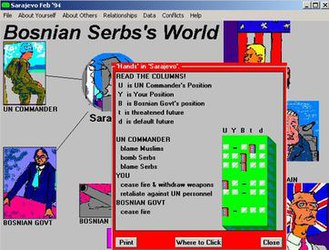
The Siege of Sarajevo was a prolonged blockade of Sarajevo, the capital of Bosnia and Herzegovina, during the Bosnian War. After it was initially besieged by the forces of the Yugoslav People's Army, the city was then besieged by the Army of Republika Srpska. Lasting from 5 April 1992 to 29 February 1996, it was three times longer than the Battle of Stalingrad, more than a year longer than the siege of Leningrad, and was the longest siege of a capital city in the history of modern warfare.

The Bosnian War was an international armed conflict that took place in Bosnia and Herzegovina between 1992 and 1995. The war is commonly seen as having started on 6 April 1992, following a number of earlier violent incidents. The war ended on 14 December 1995 when the Dayton accords were signed. The main belligerents were the forces of the Republic of Bosnia and Herzegovina, the Republic of Herzeg-Bosnia, and the Republika Srpska, the latter two entities being proto-states led and supplied by Croatia and Serbia, respectively.

The Srebrenica massacre, also known as the Srebrenica genocide, was the July 1995 genocidal killing of more than 8,000 Bosniak Muslim men and boys in and around the town of Srebrenica, during the Bosnian War. The killings were perpetrated by units of the Bosnian Serb Army of Republika Srpska (VRS) under the command of Ratko Mladić. The Scorpions, a paramilitary unit from Serbia, who had been part of the Serbian Interior Ministry until 1991, also participated in the massacre.
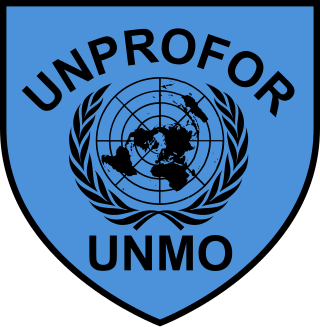
The United Nations Protection Force was the first United Nations peacekeeping force in Croatia and in Bosnia and Herzegovina during the Yugoslav Wars. The force was formed in February 1992 and its mandate ended in March 1995, with the peacekeeping mission restructuring into three other forces.

Operation Deliberate Force was a sustained air campaign conducted by the North Atlantic Treaty Organization (NATO), in concert with the United Nations Protection Force (UNPROFOR) ground operations, to undermine the military capability of the Army of Republika Srpska (VRS), which had threatened and attacked UN-designated "safe areas" in Bosnia and Herzegovina during the Bosnian War with the Srebrenica genocide and Markale massacres, precipitating the intervention. The shelling of the Sarajevo marketplace on 28 August 1995 by the VRS is considered to be the immediate instigating factor behind NATO's decision to launch the operation.

Operation Deny Flight was a North Atlantic Treaty Organization (NATO) operation that began on 12 April 1993 as the enforcement of a United Nations (UN) no-fly zone over Bosnia and Herzegovina. The United Nations and NATO later expanded the mission of the operation to include providing close air support for UN troops in Bosnia and carrying out coercive air strikes against targets in Bosnia. Twelve NATO members contributed forces to the operation and, by its end on 20 December 1995, NATO pilots had flown 100,420 sorties.
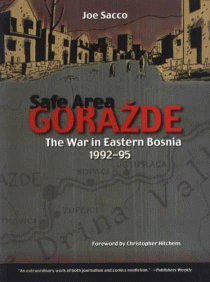
Safe Area Goražde is a journalistic comic book about the Bosnian War, written and drawn by Joe Sacco. It was published in 2000.
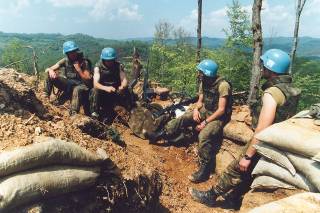
Dutchbat was a Dutch battalion under the command of the United Nations in operation United Nations Protection Force (UNPROFOR). It was hastily formed out of the emerging Air Mobile Brigade of the Royal Netherlands Armed Forces between February 1994 and November 1995 to participate in peacekeeping operations in the former Yugoslavia. It was tasked to execute United Nations Security Council Resolution 819 in the Bosniak Muslim enclaves and the designated UN "safe zone" of Srebrenica during the Bosnian War.

The Siege of Srebrenica was a three-year siege of the town of Srebrenica in eastern Bosnia and Herzegovina which lasted from April 1992 to July 1995 during the Bosnian War. Initially assaulted by the Yugoslav People's Army (JNA) and the Serbian Volunteer Guard (SDG), the town was encircled by the Army of Republika Srpska (VRS) in May 1992, starting a brutal siege which was to last for the majority of the Bosnian War. In June 1995, the commander of the Army of the Republic of Bosnia and Herzegovina (ARBiH) in the enclave, Naser Orić, left Srebrenica and fled to the town of Tuzla. He was subsequently replaced by his deputy, Major Ramiz Bećirović.
Operation Vrbas '92 was a military offensive undertaken by the Army of Republika Srpska in June–October 1992, during the Bosnian War. The goal of the operation was the destruction of a salient around the central Bosnian town of Jajce, which was held by the Croatian Defence Council and the Army of the Republic of Bosnia and Herzegovina. The intensity of fighting varied considerably and involved several major VRS offensive efforts interspersed by relative lulls in fighting. Jajce fell to the VRS on 29 October 1992, and the town's capture was followed by the destruction of all its mosques and Roman Catholic churches.

On 12 April 1993, the Army of Republika Srpska (VRS) launched an artillery attack against the town of Srebrenica, in eastern Bosnia, which left 56 dead and 73 seriously wounded, among whom were 14 children dead in a school playground. The attack came following the suspension of cease-fire talks, hours before NATO would implement a no-fly zone according to an UN resolution. VRS officials had previously told UNHCR representatives that the VRS would shell the town within two days unless it surrendered.
The Kravica massacre was one of the mass executions of Bosniaks by the Army of Republika Srpska during the Srebrenica massacre. It was committed on 14 July, 1995. It is estimated that between 1,000 and 1,500 men were killed.

The Siege of Bihać was a three-year-long siege of the northwestern Bosnian town of Bihać by the Army of the Republika Srpska, the Army of the Republic of Serbian Krajina and Bosnian Muslim dissenters led by Fikret Abdić during the 1992–95 Bosnian War. The siege lasted for three years, from June 1992 until 4–5 August 1995, when Operation Storm ended it after the Croatian Army (HV) overran the rebel Serbs in Croatia and northwest of the besieged town.
Avdo Palić was a Bosnian military officer during the 1992–1995 war in Bosnia and Herzegovina. Palić held the rank of colonel in the Army of the Republic of Bosnia and Herzegovina (ARBiH) and commanded the Bosnian government forces in the enclave of Žepa during the entire 40-month-long siege.
Drama theory is one of the problem structuring methods in operations research. It is based on game theory and adapts the use of games to complex organisational situations, accounting for emotional responses that can provoke irrational reactions and lead the players to redefine the game. In a drama, emotions trigger rationalizations that create changes in the game, and so change follows change until either all conflicts are resolved or action becomes necessary. The game as redefined is then played.
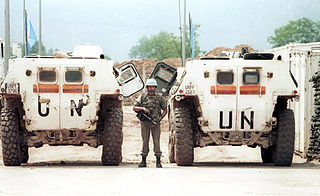
The Battle of Vrbanja Bridge was an armed confrontation which took place on 27 May 1995, between United Nations (UN) peacekeepers from the French Army and elements of the Bosnian Serb Army of Republika Srpska (VRS). The fighting occurred at the Vrbanja Bridge crossing of the Miljacka river in Sarajevo, Bosnia and Herzegovina, during the Bosnian War. The VRS seized the French-manned United Nations Protection Force (UNPROFOR) observation posts on both ends of the bridge, taking hostage 12 French peacekeepers. Ten were taken away, and two were kept at the bridge as human shields.
The Battle of Orašje was fought during the Bosnian War, from 5 May to 10 June 1995, between the Bosnian Serb Army of Republika Srpska and the Bosnian Croat Croatian Defence Council for control of the town of Orašje and its surrounding area on the south bank of the Sava River. The offensive codenamed Operation Flame-95 and referred to by Croatian sources as Operation Revenge was actually fought with varying intensity, with periods of combat interspersed by lulls lasting two to seven days. The heaviest fighting was reported on 15 May, when the VRS managed to break through a portion of the HVO defences near the village of Vidovice, but the breach was successfully contained and the lost ground was recovered by the HVO.

The siege of Goražde refers to engagements during the Bosnian War (1992–95) in and around the town of Goražde in eastern Bosnia.

On 25 and 26 May 1995, NATO conducted air strikes against positions of the Army of Republika Srpska (VRS) at Pale, as part of Operation Deny Flight, during the Bosnian War.

On 21 November 1994, NATO aircraft taking part of Operation Deny Flight carried out an airstrike on the airbase of Udbina, Croatia, then part of the self-proclaimed Serbian Republic of Krajina. Krajina Serbs had been launching air attacks on neighbour Bosnia and Herzegovina from the base in support of allied Serbian forces there, specially during the battle of Bihac. NATO forces intervened in order to deter further attacks. Two anti-aircraft SA-2 missile sites that the Serbs had used to attack Bihac in the ground-to-ground mode and to engage NATO aircraft were also destroyed in the following days. The bombing of Udbina was the largest air combat operation in Europe since World War II, and the largest combat operation in NATO's history up to that time.
